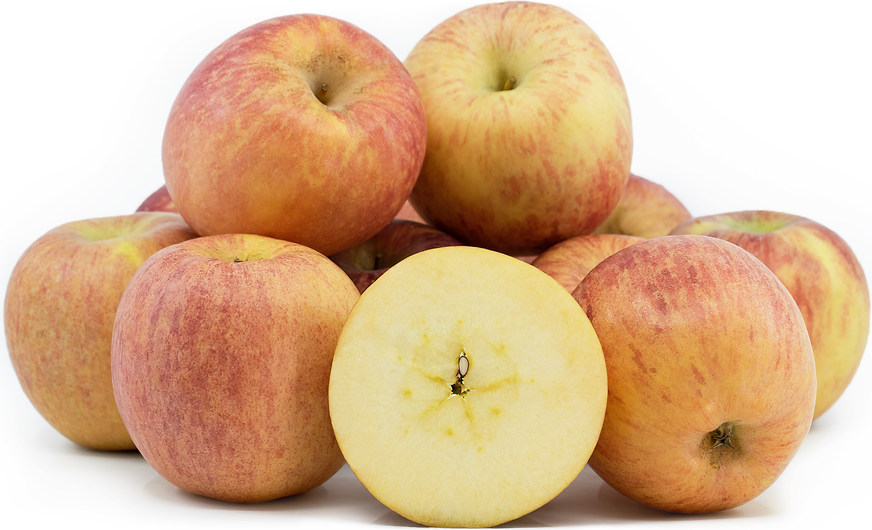


Snow Apples
Estimated Inventory, lb : 0
Description/Taste
Snow apples are round, conical, to ovate shaped fruits with a symmetrical appearance. The skin is smooth, matte, and has a yellow-green base, covered in bright red blush and striping. Underneath the surface, the flesh is soft, white, and crisp, encasing a small central core filled with black-brown seeds. The flesh may also be streaked with red and pink hues, depending on growing conditions. Snow apples are aromatic and are said to emit a strawberry-like scent. The apples also have a very sweet, subtly tart flavor with notes of spice, caramel, and wine.
Seasons/Availability
Snow apples are available in the mid to late fall and can be stored through the winter.
Current Facts
Snow apples, botanically classified as Malus domestica, are an heirloom variety that belongs to the Rosaceae family. The sweet fruits were first grown in Canada in the early 18th century and quickly became one of the most cultivated varieties, named after the apple’s white flesh and resilience in cold weather. Snow apples have also earned many other names throughout history, including Fameuse, which means “famous” in French, Chimney apples, and Snow Chimney apples. Snow apples are considered to be a dessert variety, primarily consumed fresh, and are one of the few apple cultivars that can be grown from seed without alteration or mutation. Snow apples have also gained notoriety for their alleged ties to the famous mcintosh apple, which is believed to be a descendant of the heirloom variety.
Nutritional Value
Snow apples are a good source of vitamin C, which is an antioxidant that can help boost the immune system and increase collagen production within the body. The apples also contain vitamin K, vitamin B6, riboflavin, and minerals such as potassium, copper, manganese, and magnesium.
Applications
Snow apples are best suited for both raw and cooked applications such as baking, boiling, and roasting. The apple’s soft flesh is showcased when consumed fresh, out-of-hand, or it can be sliced and tossed into green and fruit salads. Snow apples can also be blended into applesauce, pressed into juice or cider, or served with cheeses, nuts, and chocolate as an appetizer. In addition to fresh applications, Snow apples are commonly baked into tarts, pies, cakes, muffins, and cobblers or are cooked with roasted meats. Snow apples pair well with herbs such as mint, basil, and parsley, spices such as cloves, nutmeg, and cinnamon, fruits such as blackberries, cranberries, oranges, and pears, cheeses such as cheddar, blue, and goat, vanilla, potatoes, and parsnips. The fresh fruits will keep 1-2 months when stored whole and unwashed in a cool, dry, and dark place such as the refrigerator.
Ethnic/Cultural Info
Snow apples are an integral part of historical folklore throughout Canada and the Northeastern United States. In the 1730s, Snow apple trees were planted around a settlement near Lake Champlain, Quebec, but after the French-Indian war, which ended in 1763, all that remained in the Lake Champlain area were stone chimneys and apple trees. This area became known as Chimney Point, and Snow apples also earned the new name of Chimney apples after their ability to withstand the destruction. In Vermont, Snow apples were a favorite variety of American poet Robert Frost, who frequently wrote about the apple orchard outside of his home. It was rumored that Frost planted the Snow apple trees in the orchard himself, placing them closest to his house, and today there is a ninety-year-old Snow apple tree that is still growing on Frost’s property in Vermont.
Geography/History
The historical origins of Snow apples are debated, with some experts tracing the variety back to the 1600s in France, while other pomologists believe they were originally developed from French seedlings in Canada. The sweet fruits were first recorded in Canada and the United States in the 1700s and quickly became one of the most cultivated apples in French settlements. Snow apples were especially widespread in Quebec, Canada, being grown for over one hundred years, but the majority of the trees were eventually destroyed due to disease and have failed to regain popularity since the devastation. In the modern-day, Snow apple trees are a rare variety that is localized to specialty orchards and home gardens. The variety is not commercially cultivated and can be found through farmer’s markets throughout Canada and the United States.
Recipe Ideas
Recipes that include Snow Apples. One
| Gimme Some Oven |
|
Slow Cooker Apple Cider |
| Sugar Hero |
|
Apple Cider Fritters |
| The Stay at Home Chef |
|
Slow Cooker Apple Cider from scratch |




